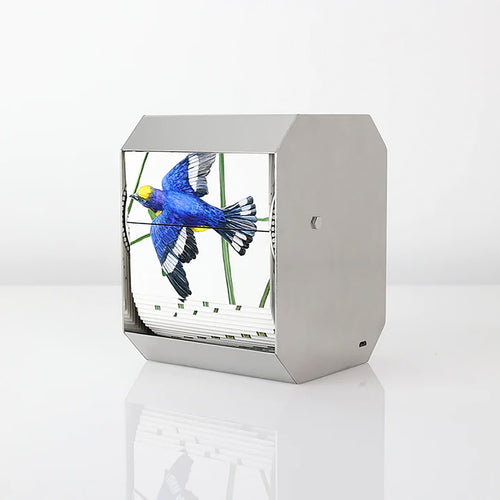Juan Fontanive is an artist interested in sequential and repetitive movement. His works explore the mechanisms and sounds of early films, especially experimental ones, as well as stop-motion animation. With a degree in literature from Syracuse University and animation from The Royal College of Art, the artist has exhibited at the New Museum (New York), the Gulbenkian Foundation (Lisbon), the Kinetica Museum (London), and the Royal Academy of Art (London), among others, and has won the Jerwood Painting Prize (2010), the Desmond Preston Drawing Prize (2004), and the Louise Wetherbee Phelps Award for Writing (1999).
In all of Fontanive’s works, we are not invited to just see. His works question vision as the most important sense, leading us to explore all of them. In works such as “Rubi” (2013) or “Ornithology” (2013), the artist brings his hummingbird drawings to life by giving them movement through a motor that turns the various pages, with the birds in different positions. The turning of the pages also creates a sound that alludes to the beating of the bird’s wings, leading us to an even greater involvement with its flight.
Drawing is also a language that Fontanive explores extensively. In "Accident 1, River 2" (2006), drawings of a cyclist in different positions are inserted into a bicycle wheel. As the wheel turns, the cyclist appears to move. Thus, the old object gains new meaning and use through the cartoon.
The artist explores analog technologies extensively. Unlike the digital world, these technologies are always accompanied by noise, a fact that the artist appreciates, as he always takes advantage of the natural sound of motors and contact between parts. In addition, Fontanive chooses all the elements that will make up the work, including pulleys, cables, and pulleys, among others, thus creating a complete interest in his objects, not just in the drawings or in what actually moves (such as colored plates).
In "Movement #1" (2008), the complex system of pulleys, steel cables and rods coordinates the movement and keeps the rotation of the thin metal discs painted black and white in perfect harmony. The movement is constant and synchronized, as if all the pieces were dancing to the same beat.
According to him, he produces films, but without using light, since his works do not take place on screens. His works are closer to the flipbook associated with motors, responsible for maintaining their constant movement. In this way, Fontanive gives life to the beings he draws with mastery.

















